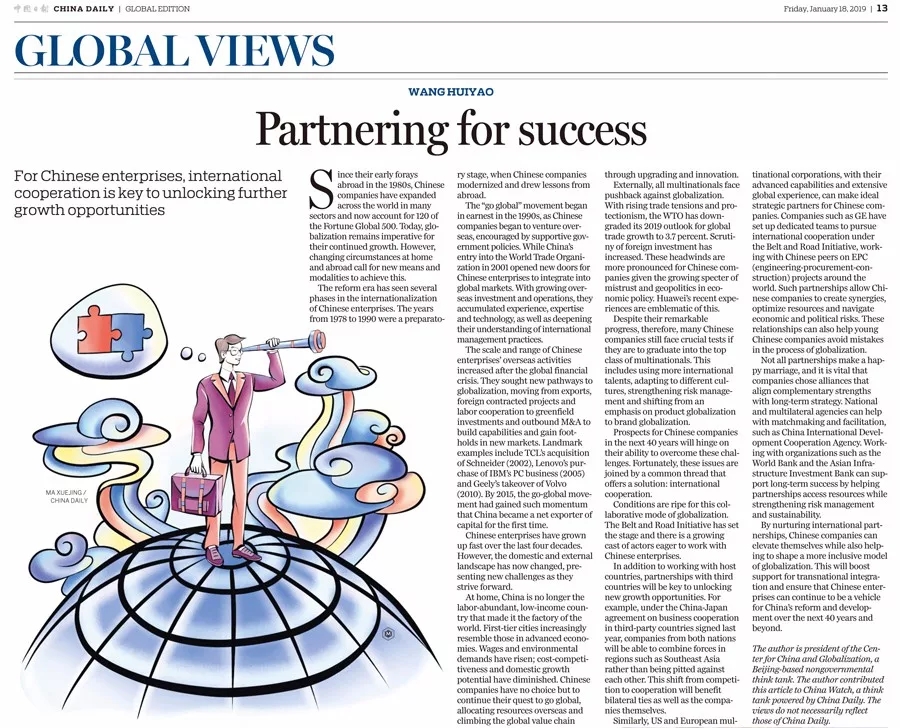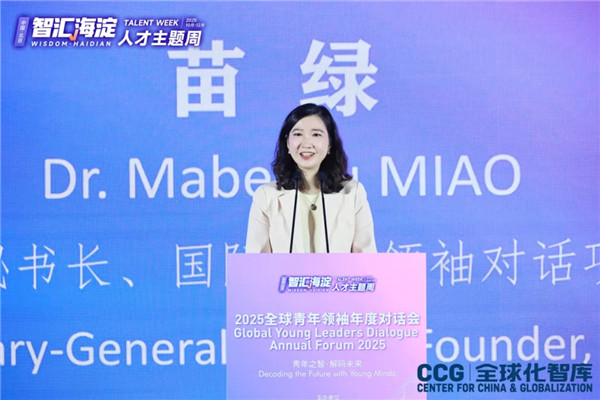Wang Huiyao: Partnering for success
January 18 , 2019
By Wang Huiyao, President of the Center for China and Globalization(CCG)
The “go global” movement began in earnest in the 1990s, as Chinese companies began to venture overseas, encouraged by supportive government policies. While China’s entry into the World Trade Organization in 2001 opened new doors for Chinese enterprises to integrate into global markets. With growing overseas investment and operations, they accumulated experience, expertise and technology, as well as deepening their understanding of international management practices.
The scale and range of Chinese enterprises’ overseas activities increased after the global financial crisis. They sought new pathways to globalization, moving from exports, foreign contracted projects and labor cooperation to greenfield investments and outbound M&A to build capabilities and gain footholds in new markets. Landmark examples include TCL’s acquisition of Schneider (2002), Lenovo’s purchase of IBM’s PC business (2005) and Geely’s takeover of Volvo (2010). By 2015, the go-global movement had gained such momentum that China became a net exporter of capital for the first time.
Chinese enterprises have grown up fast over the last four decades. However, the domestic and external landscape has now changed, presenting new challenges as they strive forward.
At home, China is no longer the labor-abundant, low-income country that made it the factory of the world. First-tier cities increasingly resemble those in advanced economies. Wages and environmental demands have risen; cost-competitiveness and domestic growth potential have diminished. Chinese companies have no choice but to continue their quest to go global, allocating resources overseas and climbing the global value chain through upgrading and innovation.
Externally, all multinationals face pushback against globalization. With rising trade tensions and protectionism, the WTO has downgraded its 2019 outlook for global trade growth to 3.7 percent. Scrutiny of foreign investment has increased. These headwinds are more pronounced for Chinese companies given the growing specter of mistrust and geopolitics in economic policy. Huawei’s recent experiences are emblematic of this.
Despite their remarkable progress, therefore, many Chinese companies still face crucial tests if they are to graduate into the top class of multinationals. This includes using more international talents, adapting to different cultures, strengthening risk management and shifting from an emphasis on product globalization to brand globalization.
Prospects for Chinese companies in the next 40 years will hinge on their ability to overcome these challenges. Fortunately, these issues are joined by a common thread that offers a solution: international cooperation.
Conditions are ripe for this collaborative mode of globalization. The Belt and Road Initiative has set the stage and there is a growing cast of actors eager to work with Chinese enterprises.
In addition to working with host countries, partnerships with third countries will be key to unlocking new growth opportunities. For example, under the China-Japan agreement on business cooperation in third-party countries signed last year, companies from both nations will be able to combine forces in regions such as Southeast Asia rather than being pitted against each other. This shift from competition to cooperation will benefit bilateral ties as well as the companies themselves.
Similarly, US and European multinational corporations, with their advanced capabilities and extensive global experience, can make ideal strategic partners for Chinese companies. Companies such as GE have set up dedicated teams to pursue international cooperation under the Belt and Road Initiative, working with Chinese peers on EPC (engineering-procurement-construction) projects around the world. Such partnerships allow Chinese companies to create synergies, optimize resources and navigate economic and political risks. These relationships can also help young Chinese companies avoid mistakes in the process of globalization.
Not all partnerships make a happy marriage, and it is vital that companies chose alliances that align complementary strengths with long-term strategy. National and multilateral agencies can help with matchmaking and facilitation, such as China International Development Cooperation Agency. Working with organizations such as the World Bank and the Asian Infrastructure Investment Bank can support long-term success by helping partnerships access resources while strengthening risk management and sustainability.
By nurturing international partnerships, Chinese companies can elevate themselves while also helping to shape a more inclusive model of globalization. This will boost support for transnational integration and ensure that Chinese enterprises can continue to be a vehicle for China’s reform and development over the next 40 years and beyond.
 Dr. Wang Huiyao, founder and president of the Center for China and Globalization(CCG), an independent think tank based in Beijing.
Dr. Wang Huiyao, founder and president of the Center for China and Globalization(CCG), an independent think tank based in Beijing.Topical News See more






